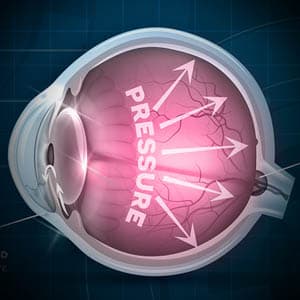What is glaucoma?
Glaucoma is a progressive ocular disease that causes permanent vision loss from damage to the optic nerve— the nerve responsible for carrying visual signals between the eye and brain.
The most common form of glaucoma occurs when there is high pressure inside the eye (intraocular pressure, or IOP), caused by a build-up of fluid that cannot drain properly. The damage to the optic nerve affects peripheral vision first, and then central vision, causing partial or complete vision loss.
Unfortunately, a cure for glaucoma and the ability to reverse it’s damage to the eye has yet to be discovered.
However, there are treatments available to help stop, or at least reduce, the progression of the disease by lowering or controlling IOP.
Anti-glaucoma eye drops
Glaucoma eye drops are a very effective treatment option, and are often the first plan of action. Glaucoma eye drops are classified by the active ingredient chemical that makes the drug effective. Your doctor will prescribe an eye drop, specific to your needs.
Types of eye drops
- Prostaglandins relax the muscles in the eyes to allow better fluid drainage, reducing build-up of IOP.
- Beta-blockers are used in a variety of glaucoma eye drops. They decrease the amount of ocular fluid production and are often prescribed in combination with prostaglandins.
- Alpha-adrenergic agonists decrease the rate of fluid production. They can be used alone or in combination with other anti-glaucoma eye drops.
- Carbonic anhydrase inhibitors decrease the rate of fluid production, and are used in combination with other anti-glaucoma eye drops
- Parasympathomimetics are very often used to control IOP in narrow-angle glaucoma. They work to increase ocular fluid drainage by opening the narrow angle where drainage occurs.
- Epinephrine decreases the rate of ocular fluid production, and increases its outflow from the eye.
- Hyperosmotic agents are used in emergencies, for patients with a severely high IOP that must be reduced immediately before permanent damage occurs. They reduce IOP by lowering ocular fluid volume.
- Combination glaucoma drugs include two different anti-glaucoma medicines. Many times, patients with glaucoma require more than one type of medication to control IOP.
If you suspect you have glaucoma, contact an eye doctor near you, who can diagnose and treat the condition.
SEE RELATED: Glaucoma: Can Meditation Help?
Laser treatment for glaucoma
Most cases of glaucoma can be controlled with eye drops. In some cases, laser surgery may be preferred or considered more effective. Glaucoma surgery involves creating avenues for increased fluid drainage to reduce IOP.
Selective laser trabeculoplasty (SLT) is the primary laser surgery performed for glaucoma treatment. This in-office laser procedure reduces IOP in cases of open-angle glaucoma. The laser is applied to the drainage system of the eye to stimulate a biochemical change that improves the fluid drainage from the eye.
- SLT can lower eye pressure by 20 to 30%.
- SLT is successful in about 80% of patients.
- According to research, the effectiveness of SLT is similar to the most effective glaucoma eye drops.
Improved IOP after an SLT treatment may last 3 to 5 years and can be repeated if needed. Complications from SLT are typically uncommon, mild and short-term.
According to research, this procedure may be equally effective as eye drops, and is a great treatment option for those who find it difficult to use their eye drops as directed.
Other surgical techniques
- Iridotomy is performed for angle-closure glaucoma. During this laser procedure, a tiny hole is created in the iris to release the build fluid and allow it to flow properly out of the regular drainage angle.
- Trabeculectomy, is a non-laser procedure that is performed in cases of advanced glaucoma, where there is already optic nerve damage and severe IOP levels. During this procedure, an artificial opening in the eye for ocular fluid drainage is created, to decrease IOP levels.
What is minimally invasive glaucoma surgery (MIGS)?
While many surgeries are often effective in lowering IOP levels, they do pose a risk of potential complications. Minimally invasive glaucoma surgery (MIGS) uses microscopic tools and devices to lower your risk of surgical complications.
1. Micro trabeculectomies
During these procedures, a microscopic tube is inserted into the eye to enable proper fluid drainage into the outer membrane of the eye (conjunctiva).
Two different devices used for this type of procedure are called: Xen Gel Stent and PRESERFLO (formerly called InnFocus and Microshunt).
The iStent® is the most frequently performed MIGS for mild to moderate open angle glaucoma.
This procedure involves implanting a small titanium microtrabecular device to create a bypass between the front chambers of the eye and its natural drainage pathway. The iStent enables improved outflow of fluid from the eye, through its natural drainage system— lowering IOP levels.
Benefits of iStent:
- Typically easily combined with cataract surgery— improving IOP with minimal use of pressure lowering eye drops.
- Minimal damage of normal eye tissue.
- Easier to perform, faster to recover from, and safer than many glaucoma surgeries.
- May help reduce a patient’s medication burden— reducing the cost, inconvenience, or side effects of using eye drops.
- May help delay or prevent the need for additional surgical interventions in the future.
2. Trabecular surgery
This type of surgery is recommended for early to moderate stages of glaucoma, as the IOP does not reach very low levels through this procedure.
This procedure uses tiny devices and equipment to cut through the trabecular meshwork, without causing harm to any other tissues in the drainage pathway. Using a special contact lens on the eye, a tiny device is inserted into the eye.
The trabecular meshwork can either be destroyed with a trabectome or trab360, or bypassed using an iStent. These procedures are FDA-approved but generally don’t reduce the eye pressure to a low enough level for them to be effective in more advanced stages of glaucoma.
3. Suprachoroidal shunts
This surgery can successfully lower IOP levels and can be effective in treating moderate to severe glaucoma.
This procedure uses tiny tubes with very small openings, called glaukos shunts, to connect the front of the eye to the suprachoroidal space between the retina and the wall of the eye. The shunt serves to enable proper fluid drainage from the eye.
LEARN MORE: Guide to Eye Conditions
Schedule an appointment with an eye doctor for a comprehensive eye exam, and to discuss any questions you may have about treating your eye condition.
If you have recently been diagnosed with glaucoma, there are many different treatment methods that can lower the pressure within your eye to reduce vision loss, and preserve remaining vision.
Your eye doctor will discuss the most appropriate treatment options for you.










